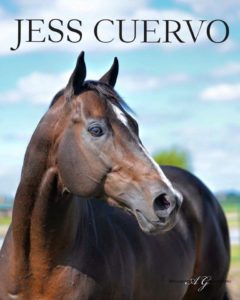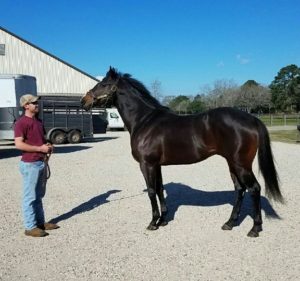By Barbara Newtown.
Steven DeVille is the Stallion Manager at Acadiana Equine Hospital at Copper Crowne and at LACER, the Louisiana Center for Equine Reproduction. The facilities are both in Opelousas, Louisiana, and are only a couple of miles apart. The businesses started separately, but now they are merged together under the guidance of Dr. Eddie Cramer and Dr. James “Sonny” Corley.
The stallions live at Copper Crowne and most of the mares live at LACER. In the springtime Steven DeVille hustles back and forth between the two locations, either carrying fresh Quarter Horse semen to mares at LACER for artificial insemination, or hauling Thoroughbred mares to Copper Crowne for live cover with Thoroughbred stallions. (The Thoroughbred breed only allows live cover. Quarter Horses may be bred by live cover or by A.I.) In the summer Steven spends time at LACER prepping yearlings for sales. And every day he checks on the well-being of the Copper Crowne stallions. Steven also advises owners about which stallions would probably blend well with their mares, based on analysis of conformation and pedigrees.
Steven, how did you get started in the breeding business?
My dad is Dr. Phillip DeVille, of DeVille Veterinary Clinic in Abbeville, Louisiana. His specialty is equine reproduction. He used to manage the reproduction at Robicheaux Ranch and Hart Farms. Lately he’s mainly focused on Robicheaux Ranch and a bunch of smaller farms.
I’ve grown up going to barns with my dad and getting to know Quarter Horse breeders all over the state. I’ve been lucky to get my foot in the door because of the opportunity to meet everybody. I’m only 25, but I feel like I’ve been in this business for as long as some of the elders in the game! Yes, I’ve been around horses a long time. There are pictures of me at ages 2 and 3 on a horse all by myself.
I worked at Robicheaux Ranch as a kid in the summertime up through my high school years. While attending college at McNeese State University studying Equine Science, I worked three years for Dr. Larry Findley at Delta Equine in Vinton. Dr. Findley started introducing me to not only the veterinary side and the hospital side, but also a lot to the reproductive side. Once I came to work at Copper Crowne with Dr. Cramer, he started sending me to more classes and showing me “hands-on” things.
Tell me how you prepare and transport the semen for A.I.
We collect the stallions at Copper Crowne and there I analyze the semen. We get a total sperm count for the whole collection, and that tells me how many mares I can service at one time. I determine whether there’s enough for the number of mares I have booked. We ship semen to other cities or states, too.
I extend the semen, four parts extender to one part semen, divide it equally into syringes, put them into boxes with ice packs, and mail it or take it down the road to LACER.
We use A.I. to breed our warmbloods. I prefer it—I think it’s safer for the mare and the stallion than live cover.
Correct. Sometimes the mare might not be willing to take a stallion. Also, sometimes a mare or stallion might have fertility issues. A.I. sometimes allows a pregnancy to happen that might not be possible with live cover.
When you insert the pipette into the uterus of the mare, do you try to direct the semen towards the side that has the ripe follicle?
When we do regular A.I. with a large volume dose, we simply infuse the semen into the uterus, and there’s enough semen to travel up both horns and find the egg. Now, when we centrifuge the collected semen, it’s a lower volume and more concentrated; then we will direct it up a certain horn, depending on which side the follicle is on.
Do you always use a breeding mount when you collect a stallion?
[Breeding mount, dummy, and phantom are terms for the same thing: a support for the stallion’s weight during breeding. The mare in heat, either the mare to be infused with semen or a “teaser” mare, stands alongside or in front of the mount. The stallion is encouraged to rise up onto the mount. A handler directs the stallion’s penis into the warmed and lubricated “artificial vagina.”]
Most of the time I use a mount. Most of my stallions are trained to jump the dummy. However, there have been times where stallions have been pasture bred previously and they are accustomed to being on top of a mare. I will artificially collect those stallions, but I use the mare as a dummy instead of an actual phantom. And I had a stallion that had issues with his front feet and couldn’t get on top of a mare or a dummy, so I had to “ground collect” him.
Tell me about the Quarter Horse stallion Jess Cuervo.
He’s a younger stallion. His sire is Corona Cartel, whose line lately has proven to be a very hot line of stallions. His dam, by Mr Jess Perry, has produced two or three other stakes horses. Jess Cuervo retired sound, has had no surgeries whatsoever, and is a very correct, well-balanced, and sensible horse. Everything about him screams “Big Time Stallion Potential.” I understand that everybody in the stallion business wants to give their stallion a chance, but there’s something unique about this horse. He has that little edge to him that just makes you take notice.
Jess Cuervo is a freshman sire, which means his first group of babies will race this year. Last year this same group went to the sales, and Jess Cuervo was Louisiana’s number one leading first-year sales sire. Compared to all the stallions in the state, he was fourth overall, with an $18,000 average on his foals. The three stallions that topped him were Game Patriot, Heza Fast Dash, and Jess Louisiana Blue. For a freshman stallion to come in and accomplish that, everyone takes notice.
Selling well is only part of the game, but the feedback from the trainers that I’ve heard over the last couple of months has been outstanding. The colts are very intelligent—they pick up everything extremely fast. A couple of guys told me that they are really excited to get this season cranked up. They think they have something special in their barns. You hope for the best and hope all the hard work pays off.
What accounted for the excitement about the Jess Cuervo yearlings? Was it just the way they looked, or was it the interesting combo of Corona Cartel and a dam by Mr Jess Perry? The yearlings sold so well, and yet there were no progeny race records for people to consult.
The owner and I wanted a lot of numbers—lots of foals—but we also realize that quality is better than quantity. We wanted to make sure that we had the best mares we possibly could have. We held him [his stud fee] pretty solid, and because of that it attracted some of the better mares in the state and even outside the state, from Texas, Oklahoma, and New Mexico.
The mare power that we bred Jess Cuervo to just about equaled the mares that the top three stallions in the state were getting. Everybody came up and told me, “Man, I could see that was a Jess Cuervo just by the look!” His foals had a certain class about the way they looked and acted.
What was Jess Cuervo’s favorite distance?
Jess isn’t very large; that’s typical of Corona Cartels. They are solid, though, and well put together. Jess stands roughly at 15.2. Most of the time smaller horses tend to go best between 300 and 350 yards. But Jess is unique in that he likes to go the classic distance of 440, right at a quarter of a mile. There is more money in those races.
Will we see some Jess Cuervos at the Mardi Gras trials at Louisiana Downs?
Yes, ma’am! Supposedly there’s a handful starting the trials. I do have reports of some other Cuervos that may be starting in some maiden races up there, just to get their minds right and prepped for the Delta Downs meet. Delta is where we’ll see the majority of his foals.
I have to ask about the Thoroughbred stallion Songandaprayer. I had to look twice when I saw him on the LACER website. He looks like an event horse to me!
Not many Thoroughbreds can be described like Songandaprayer. He’s almost like an all-around Quarter Horse. You could use him in any competition! He’s 16.3, very good boned, nice and wide feet, and very intelligent. He has $40 million in progeny earnings in Thoroughbred racing, but he could fit well anywhere, in Quarter Horse competitions or even your sports, jumping and dressage, just going by the size and intelligence of his babies.
What was his best distance?
He was a sprinter—six to seven furlongs. They ran him in the Kentucky Derby and even to this day he still holds the record for the fastest opening half mile. One mile equals eight furlongs, so by the time he got to the mile, the rest of the field was just cranking up! He never had a true chance in the race, but the owners couldn’t pass up the prestige. And the fact that he has the fastest opening half mile in 130 years of running the Kentucky Derby—well, that’s a true testament to his speed. Breeders of sprinting Thoroughbreds will know that fact forever, and so will some Quarter Horse breeders. Songandaprayer can do a one-turn or a two-turn route—he can adjust to whatever situation he comes to.
I notice that four of the five Quarter Horse stallions you stand at Copper Crowne have Mr Jess Perry close up on either the top or the bottom of their pedigrees.
Mr Jess Perry has proved himself to be a very substantial part of the Quarter Horse industry. He started in Louisiana and has become a national icon. He’s just added so much. It’s always an advantage to put Jess Perry in your breeding operation.
Thank you, Steven!






